So i just started reloading a few weeks ago. Started out with 223. Im using the Hornady 10th edition manual that came with my press bundle kit. Im following the loading data for powder that matches the bullets im loading but found that the factory rounds i have are not seated as deep as the book says they should be. Could be because of the factory powder being used vs what im using. Blc-2 for my 223. My book says for a 223 55g i need a C.O.L of 2.200, max is 2.260, my factory 223 round is 2.230. I figured that loading to the factory spec of 2.230 vs 2.200 would slightly decrease velocity since its not seated as deep, is that a correct asumption? I also trimmed them to 1.750 before seating like the book said, that also matched my factory round length as well. I loaded 10 rounds, went to the range. All went off without issue, cycled perfect, hit the paper at 100 yards. Wasnt testing for accuracy yet but more for function to make sure they worked. No signs of over pressure on the brass, cases looked perfect after firing. I didnt load to max velocity, started at the lower end and will work my way up. Does anyone with more experience see any issues with seating this way? Should i just follow the book and seat them the extra .030? Ive watched some videos and read forums, it seems everyone has their own preference on C.O.L. as long as its under max and at or above what the book lists for the bullet selected. Thank you.
Navigation
Install the NWFA app
How to install the app on iOS
Follow along with the video below to see how to install our site as a web app on your home screen.
Note: This feature may not be available in some browsers.
More Options
You are using an outdated browser
The browser you are using is likely incompatible with our website. We recommend upgrading your current browser or installing an alternative.
JavaScript is disabled
Our website requires JavaScript to function properly. For a better experience, please enable JavaScript in your browser settings before proceeding.
-
Join the #1 community for gun owners of the Northwest
We believe the 2nd Amendment is best defended through grass-roots organization, education, and advocacy centered around individual gun owners. It is our mission to encourage, organize, and support these efforts throughout Oregon, Washington, Idaho, Montana, and Wyoming.Free Membership Benefits
- Fewer banner ads
- Buy, sell, and trade in our classified section
- Discuss firearms and all aspects of firearm ownership
- Join others in organizing against anti-gun legislation
- Find nearby gun shops, ranges, training, and other resources
- Discover free outdoor shooting areas
- Stay up to date on firearm-related events
- Share photos and video with other members
- ...and much more!
Member 34319
- Messages
- 17,146
- Reactions
- 37,059
The point of reloading is to decrease variables, well if hand loading for more precise ammunition.
Factory loads, especially bulk factory loads, are anything but 100%. Hence the difference you have experienced with the case overall length.
The manual says to start at 2.20 but not go over 2.26. That is the playing field per this manual.
Once you get further along you may try loading not only various powders, but various seating depths, to see what your rifle likes best.
Go slow, perform one variable at a time. IE, find a consistent powder and powder charge that produces smaller spreads before messing around with bullet depths.
Factory loads, especially bulk factory loads, are anything but 100%. Hence the difference you have experienced with the case overall length.
The manual says to start at 2.20 but not go over 2.26. That is the playing field per this manual.
Once you get further along you may try loading not only various powders, but various seating depths, to see what your rifle likes best.
Go slow, perform one variable at a time. IE, find a consistent powder and powder charge that produces smaller spreads before messing around with bullet depths.
As long as it fits in the magazine, and doesn't jam into the lands you should be fine. Going too short however, can raise pressures a bit.
The book is a starting point, but not necessarily the end point.
Bolt action rifles give one a little more leeway when it comes to Bullet seating depth.
The book is a starting point, but not necessarily the end point.
Bolt action rifles give one a little more leeway when it comes to Bullet seating depth.
Last Edited:
Bronze Supporter
- Messages
- 3,519
- Reactions
- 7,480
In the ar platfom you will usually run out of mag length before getting rounds that contact rifling. Make a dummy round with the bullet seated so tip it is about .010" shy of hitting inside mag with no crimp. Cycle this round by hand and measure it with calipers to make sure it didn't set bullet back any. If it remained the same, try shortening coal in .002-.005" steps until you find the coal that provides the best accuracy. This will need to be done for every different bullet you plan on using. Factory rounds coal is almost alway shorter than needed in most rifles due to having to fit a broad spectrum of different chambers. This shorter coal usually hinders accuracy somewhat.
- Messages
- 4,913
- Reactions
- 12,782
The manual says to start at 2.20 but not go over 2.26. That is the playing field per this manual.
FWIW, most manuals consider that you are probably sooting an AR and the COL is based on the magazine and feeding. If you are in a bolt action or whatever else or even single feeding, you can seat the bullet almost any length. For accuracy you generally want the bullet when in battery to come into contact with the rifling in the throat of the barrell. Some bullets like to jump .001-.005" to the lands, others like to be jammed in hard.
As long as your powder is within recommended amounts, your seating is a variable you should feel free to adjust based on your results in your rifle. Your only other constraint is that you may have to cycle from a magazine and that may limit you.
Member 34319
- Messages
- 17,146
- Reactions
- 37,059
Correct, some manuals now have separate data for 223. One for bolt action, one for semi autos.FWIW, most manuals consider that you are probably sooting an AR and the COL is based on the magazine and feeding. If you are in a bolt action or whatever else or even single feeding, you can seat the bullet almost any length. For accuracy you generally want the bullet when in battery to come into contact with the rifling in the throat of the barrell. Some bullets like to jump .001-.005" to the lands, others like to be jammed in hard.
As long as your powder is within recommended amounts, your seating is a variable you should feel free to adjust based on your results in your rifle. Your only other constraint is that you may have to cycle from a magazine and that may limit you.
I even have one manual that has a third set of data for pistols in 223.
Member 5605
- Messages
- 11,671
- Reactions
- 23,700
And some actually have 5.56 specs!Correct, some manuals now have separate data for 223. One for bolt action, one for semi autos.
I even have one manual that has a third set of data for pistols in 223.
- Messages
- 2,469
- Reactions
- 2,926
So i just started reloading a few weeks ago. Started out with 223. Im using the Hornady 10th edition manual that came with my press bundle kit. Im following the loading data for powder that matches the bullets im loading but found that the factory rounds i have are not seated as deep as the book says they should be. Could be because of the factory powder being used vs what im using. Blc-2 for my 223. My book says for a 223 55g i need a C.O.L of 2.200, max is 2.260, my factory 223 round is 2.230. I figured that loading to the factory spec of 2.230 vs 2.200 would slightly decrease velocity since its not seated as deep, is that a correct asumption? I also trimmed them to 1.750 before seating like the book said, that also matched my factory round length as well. I loaded 10 rounds, went to the range. All went off without issue, cycled perfect, hit the paper at 100 yards. Wasnt testing for accuracy yet but more for function to make sure they worked. No signs of over pressure on the brass, cases looked perfect after firing. I didnt load to max velocity, started at the lower end and will work my way up. Does anyone with more experience see any issues with seating this way? Should i just follow the book and seat them the extra .030? Ive watched some videos and read forums, it seems everyone has their own preference on C.O.L. as long as its under max and at or above what the book lists for the bullet selected. Thank you.
The best OAL is pretty much just going to be what your rifle likes the best. Play around with it and see what you end up with.
Hornady makes a handy device that lets you measure your rifles chamber to the lands to let you know what is going on. As you go shorter the pressure will increase, but as you approach the rifling the pressure will also increase, so that is something to be aware of,.
Play around at reduced loads, when you find the sweet spot, then adjust your powder charges.
- Messages
- 3,115
- Reactions
- 6,599
1. Learn how to find your lands with each bullet you intend to load.
2. Stay off the lands by at least .020", especially if it's for hunting.
3. Measure your mag box and make note of that in your load data.
4. Keep a notebook and keep record of all the bullets you will load for your rifles and their OAL. Make note of where the lands are and remember to stay off the lands by .020". Please don't listen to some others that say "jam the bullet in hard". Save yourself the trouble and stay off the lands. If you can't load extremely accurate ammo by staying off the lands, you shouldn't be reloading. If having trouble always remember to go back to #2 and re-read.
5. Buy yourself a good caliper for measuring OAL.
6. I'll tell you guys a little secret. Most all of my ammo is loaded to .020" off the lands. When you are developing a good load, you just have to look for optimum charge weight. Most times you don't even have to f around with seating depth. You do, however, have to know where your bullet is in relationship to the lands..
Here are some 10 shot groups I fired off today with the bullets at .020" off the lands. This is new starline brass, so after it's all fireformed, I'll dabble with the charge wt. again and fine tune the load. Not going to touch the seating depth though:

Here's another group fired with the bullet off the lands by the same amount:

Another fired from my very old (1956) winchester model 70 and an el-cheapo winchester hunting bullet:

However, since you are talking 223 rem, the reason the book max OAL is 2.260" is because an AR magazine is limited to that length. In this case (with an AR), you will most likely not be able to get to the sweet spot off the lands and you will have to make due with the mag box restriction in OAL. This is not a bad thing, as you can load to that length and just find your optimum powder charge. This stuff is not overly complicated, but you do need to have an understanding of the mechanics involved. Keep in mind, if you jam your bullets into the lands, the bullet will most likely stick in the lands of the rifle and upon trying to pull the cartridge out, it will spill powder all inside the mag well of the rifle. Just a word to the wise. Jamming bullets into the lands is a bad habit to get into, especially if you are looking for a totally reliable load for your hunting rifle. If it's an AR you are loading for, I usually load to less than the mag box length by .005" for reliability. Remember reliable ammo doesn't mean inaccurate ammo:


2. Stay off the lands by at least .020", especially if it's for hunting.
3. Measure your mag box and make note of that in your load data.
4. Keep a notebook and keep record of all the bullets you will load for your rifles and their OAL. Make note of where the lands are and remember to stay off the lands by .020". Please don't listen to some others that say "jam the bullet in hard". Save yourself the trouble and stay off the lands. If you can't load extremely accurate ammo by staying off the lands, you shouldn't be reloading. If having trouble always remember to go back to #2 and re-read.
5. Buy yourself a good caliper for measuring OAL.
6. I'll tell you guys a little secret. Most all of my ammo is loaded to .020" off the lands. When you are developing a good load, you just have to look for optimum charge weight. Most times you don't even have to f around with seating depth. You do, however, have to know where your bullet is in relationship to the lands..
Here are some 10 shot groups I fired off today with the bullets at .020" off the lands. This is new starline brass, so after it's all fireformed, I'll dabble with the charge wt. again and fine tune the load. Not going to touch the seating depth though:
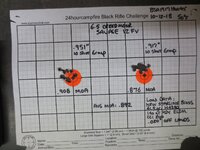
Here's another group fired with the bullet off the lands by the same amount:
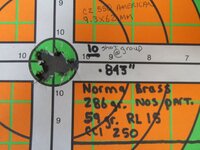
Another fired from my very old (1956) winchester model 70 and an el-cheapo winchester hunting bullet:
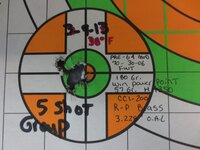
However, since you are talking 223 rem, the reason the book max OAL is 2.260" is because an AR magazine is limited to that length. In this case (with an AR), you will most likely not be able to get to the sweet spot off the lands and you will have to make due with the mag box restriction in OAL. This is not a bad thing, as you can load to that length and just find your optimum powder charge. This stuff is not overly complicated, but you do need to have an understanding of the mechanics involved. Keep in mind, if you jam your bullets into the lands, the bullet will most likely stick in the lands of the rifle and upon trying to pull the cartridge out, it will spill powder all inside the mag well of the rifle. Just a word to the wise. Jamming bullets into the lands is a bad habit to get into, especially if you are looking for a totally reliable load for your hunting rifle. If it's an AR you are loading for, I usually load to less than the mag box length by .005" for reliability. Remember reliable ammo doesn't mean inaccurate ammo:
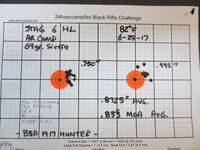
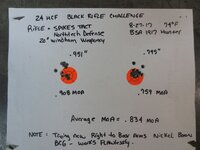
Last Edited:
- Thread Starter
- #10
Thank you for the input, great info/ advise here. Overall, reloading doesnt seem complicated but there are lots of little steps to go through. I like tinkering so im sure ill fit right in with reloading. Im already taking notes on the things ive done already so i can keep track of everything. Im going to load some more test rounds at various charges next and head back to the range. From videos ive watched, too many to count now, it seems like 5 shots is enough to get a good test group. I am reloading for an AR so the mag will limit c.o.l. so it sounds like measuring to the lands is not necessary as i wont reach them unless i hand feed each round. When i start doing other types ill definately take those measurements. Should i do that for my 9mm and .45 pistol or are pistols different? Thanks again
- Messages
- 2,469
- Reactions
- 2,926
Thank you for the input, great info/ advise here. Overall, reloading doesnt seem complicated but there are lots of little steps to go through. I like tinkering so im sure ill fit right in with reloading. Im already taking notes on the things ive done already so i can keep track of everything. Im going to load some more test rounds at various charges next and head back to the range. From videos ive watched, too many to count now, it seems like 5 shots is enough to get a good test group. I am reloading for an AR so the mag will limit c.o.l. so it sounds like measuring to the lands is not necessary as i wont reach them unless i hand feed each round. When i start doing other types ill definately take those measurements. Should i do that for my 9mm and .45 pistol or are pistols different? Thanks again
If you are loading to fit in a mag then like you said that will be the determining factor, just load to mag length in that case.
For pistols just load short enough that they function, without being so short that they spike in pressure or you cant crimp. It's not really that critical for a handgun.
- Messages
- 643
- Reactions
- 999
62gr soft points and Nosler 77gr otm have given me stellar results for me with BLC-2 out of a 16"ruger AR556.
For seating depths I used to be really concerned with but for the most part if it has a cannalure seat to that and you should be in the green, but even then proceed with caution as some brass is from the factory really short such as FC223 so seating to the cannalure may end up on the short side.
In the end keep it simple, dont overthink it, and have fun.
For seating depths I used to be really concerned with but for the most part if it has a cannalure seat to that and you should be in the green, but even then proceed with caution as some brass is from the factory really short such as FC223 so seating to the cannalure may end up on the short side.
In the end keep it simple, dont overthink it, and have fun.

Probably good advice to stay off the lands, especially if it is a hunting rifle. Provided you have a means to measure though, getting right up to the lands is okay. Back off .005 from there and you will be fine. If you don't already have a comparator, consider investing in one. Bullets can really vary from base to tip, while they don't vary much at all from base to a point on the ogive.
I do load into the lands on several rifles and have found the best accuracy close to hard jam on them. These are single shot target rifles and a couple of 20 caliber sage rat rifles. The issue with loading into the lands other than the potential pressure problems, is if you have to extract a live round, the lands can pull the bullet and you have powder all over the place and it can get into your trigger.
I do load into the lands on several rifles and have found the best accuracy close to hard jam on them. These are single shot target rifles and a couple of 20 caliber sage rat rifles. The issue with loading into the lands other than the potential pressure problems, is if you have to extract a live round, the lands can pull the bullet and you have powder all over the place and it can get into your trigger.
Bronze Supporter
- Messages
- 16,798
- Reactions
- 27,584
Since you were not specific enough. Example: not all 55 grain FMJ bullets are alike. Then.....some people reload for SHTF situations, not bench rest competition.
So then, note.....
That different brands of bullets will (likely) have their cannelure placed at different places.
So, if you like to crimp into the cannelure. Well, you'll probably put the manual to the side when speaking of COAL. Of course, still keeping the internal magazine length and functioning.....as your guide to finding what works.
I mentioned cannelure......
So mind you that, I'm not speaking of "ultimate accuracy" here. Just "functioning military style ammo". With good enough accuracy. Maybe, on par with factory military rounds or slightly better. Better.....due to your selection of product components and your ability to keep things more consistent from round to round.
Aloha, Mark
So then, note.....
That different brands of bullets will (likely) have their cannelure placed at different places.
So, if you like to crimp into the cannelure. Well, you'll probably put the manual to the side when speaking of COAL. Of course, still keeping the internal magazine length and functioning.....as your guide to finding what works.
I mentioned cannelure......
So mind you that, I'm not speaking of "ultimate accuracy" here. Just "functioning military style ammo". With good enough accuracy. Maybe, on par with factory military rounds or slightly better. Better.....due to your selection of product components and your ability to keep things more consistent from round to round.
Aloha, Mark
Last Edited:
Silver Supporter
- Messages
- 9,108
- Reactions
- 16,629
If your COAL is not constrained by a magazine, make up a dummy round.
Set the bullet long.
Go outside and "smoke" the bullet with a wooden match.
You're putting a black, sooty coating on the bullet.
Now go chamber it and then notice how the lands lands are meeting the bullet.
Seat the bullet until you're just off the lands. Re-smoke as necessary.
This is your set-up dummy round for that cartridge/bullet and for that particular gun.
Place in in with that box of bullets for the next set-up.
Set the bullet long.
Go outside and "smoke" the bullet with a wooden match.
You're putting a black, sooty coating on the bullet.
Now go chamber it and then notice how the lands lands are meeting the bullet.
Seat the bullet until you're just off the lands. Re-smoke as necessary.
This is your set-up dummy round for that cartridge/bullet and for that particular gun.
Place in in with that box of bullets for the next set-up.
Since you were not specific enough. Example: not all 55 grain FMJ bullets are alike. .
So then, note.....
That different brands of bullets will (likely) have their cannelure placed at different places.
Lots of good advice here, but the quote above comes closest to answering the simple question. The reason your book-derived OAL was different from the factory ammo was bullet design. The bullet profile/curvature/ogive dictates seating depth in this matter.
As a novice hand loader, you might stick to using bullets that have the cannelure on them. That will tell you how deep to seat. Even then, there are some rifles that won't like what the bullet factory decided was optimal. But these will be exceptions.
A lesson I learned years ago re. the ogive on .224 bullets. Commercial (read bolt action) sporting rifles don't like FMJ military type bullets. Had to learn it in a .222 Rem, just had to learn it all over again in a .223 Rem. (here place the emoticon for banging head against wall)
Share This Discussion
Similar threads
Upcoming Events
New Classified Ads
-
Reloading Dies, 300 H&H,300 Win Mag,220 swift,338 Winchester,30.06
- Started by NJACamaro
- Replies: 0
-
-
-
-
-
Kimber Eclipse Custom II 1911 with holster and ammo.
- Started by mrgibbs95
- Replies: 0
-
Winchester 200gr Open Tip Subsonic for 300 Blk
- Started by pharris95
- Replies: 0
-
Burris XTR III 3.3-18X50 SCR2 illuminated
- Started by T38
- Replies: 0
-
-
Support Our Community
If our Supporting Vendors don't have what you're looking for, use these links before making a purchase and we will receive a small percentage of the sale











